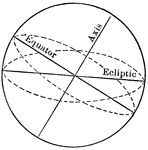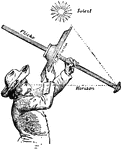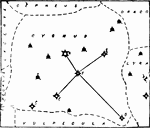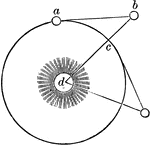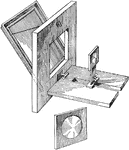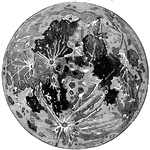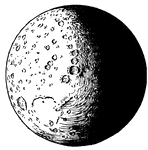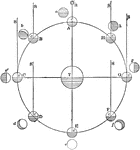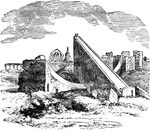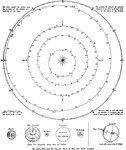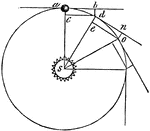The Astronomy ClipArt gallery offers 89 images of the tools of astronomy as well as numerous stars and constellations that can be seen in the night sky. See also the Telescopes and Binoculars ClipArt gallery.

Annual Parallax
"Suppose a to be a stationary celestial object, then as the Earth makes her annual revolution around…
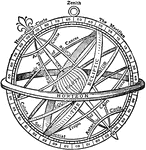
Armilla
"Armillary Sphere, an instrument used in astronomy. In its simplest form, consisting of a ring fixed…
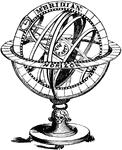
Armillary Sphere
"An arrangement of rings, all circles of a single sphere, intended to show the relative positions of…

Astrolabe
"Sir Francis Drake's Astrolabe; an obsolete astronomical instrument of different forms, used for taking…
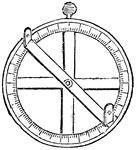
Astrolabe
"Originally used for any instrument used for observing stars; afterwards used for an instrument for…
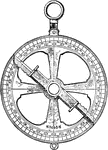
Later Astrolabe
A historical astronomical instrument used to predict positions of the Sun, Moon, planets and stars.

Regiomontanus' Astrolabe
A historical astronomical instrument used to predict positions of the Sun, Moon, planets and stars.

Aurora Borealis
Auroras are caused by the passage of electricity through the rare air of the upper regions.
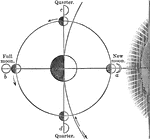
Cause of the Phases of the Moon
During new and full moon, the earth, moon, and sun are all in the same straight line, but, that during…
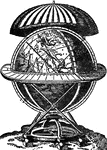
Globe of Copernicus
"Copernicus, or Nicholas Koppernigk, was the founder of modern astronomy. From a school in Thorn Copernicus…
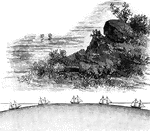
Curvature of the Earth's Surface
If the earth were flat, as soon as an object appeared on the horizon we would see the upper and lower…
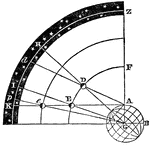
Diurnal Parallax
"If we suppose a spectator placed at G, in the Earth's center, he would see the moon E, among the stars…
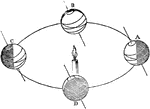
Earth Axis
"Now it is the inclination of the Earth's axis, as above described, which causes the lengths of the…

Earth Axis
"Now it is the inclination of the Earth's axis, as above described, which causes the lengths of the…
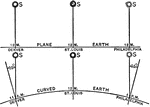
Earth Curvature
"The sun is so far away that it would appear at the same angle from Philadelphia, St. Louis, and Denver,…
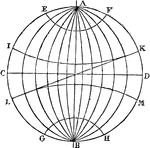
Earth Divisions
"The Earth, whose diameter is 7,912 miles, is represented by the globe, or sphere. The straight line…
Earth's Axis Perpendicular to Plane of Orbit
"The earth shown as it would be if its axis were perpendicular to the plane of the orbit." -Wiswell,…

Inclination of Earth's Axis
"A quadrant, or one fourth of a circle. The oblique lines indicate various angles with the base. The…

Spheroidal Form of the Earth
"When one is at sea, or standing on the sea-shore, the first part of a ship seen at a distance, is its…
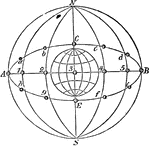
Suns in the Equator and Ecliptic
"Were the Earth's orbit a perfect circle, and her axis perpendicular to the plane of this orbit, the…
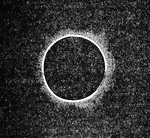
Eclipse
"An Eclipse is an interception or obscuration of the light of the sun, moon, or other heavenly body…

Elliptical Orbit
"The elliptical circle being supposed to be the Earth's orbit, with the Sun, S, in one of the foci.…
Spring Equinox and Autumn Equinox
"Relative positions of the earth and the sun on March 21 (spring equinox) and September 21 (autumn equinox)…
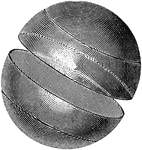
Great Circle
A Great Circle is one which would be formed on the earth's surface by a plane passing through the earth's…
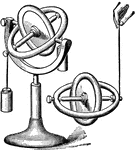
Gyroscope
"The Gyroscope is an instrument constructed by M. Foucault to make the rotation of the earth visible.…

Heliometer
"Dollond's divided object-glass heliometer of the third type. A is the end of the reflecting telescope,…

Heliometer
"No part of the equatorial mounting is shown in the figure, as it resembles every respect that usual…

Heliometer
"The type of instrument which resulted from Russian labors. The brass tube, strengthened at the bearing…
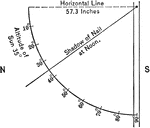
Heliotrope
An instrument used in geography to measure angles of the sun at different times of the day.
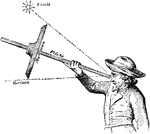
Jackstaff
An instrument which could more readily adapt itself to the swaying of the observer's body in a sea-way,…

Longitude
"Let this figure represent the Earth, N being the north pole, S the south pole, and E W the equator.…

Meridians and Parallels
The Meridian of any given place is that half of the meridian circle which passes through that place…
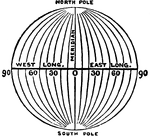
Meridians of Longitude
Meridians of longitude are the imaginary vertical lines that run around the Earth. These lines divide…

Moon
The satellite of the earth, and classed as one of the secondary planets. It revolves around the earth…
Moon Eclipse
"When the Moon falls into the shadow of the Earth, the rays of the Sun are intercepted, or hid from…

Moon Phases
"Let S be the Sun, E the Earth, and A, B, C, D, F, the Moon in different parts of her orbit. Now when…

Finding the North Star
"Two stars in the Big Dipper opposite the handle indicate the direction toward the North Star, which,…

Oblate and Prolate Spheroid
The shape of the earth is that of a round ball or sphere slightly flattened at two opposite sides. Such…
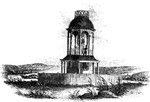
Observatory
"The observatory. This view is from the field, looking north. On the left is seen the winding Schuylkill,…

Planet Distance
"Relative distance of the Planets. Having now given a short account of each planet composing the solar…
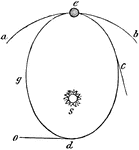
Planet Motion
"Elliptical Orbits.—It has been supposed that the Sun's attraction, which constitutes the Earth's…
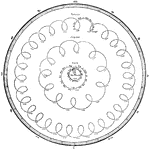
Planet Rotations
"The motion of Saturn, Jupiter, and Mars with respect to Earth." — Encyclopedia Britanica, 1893
